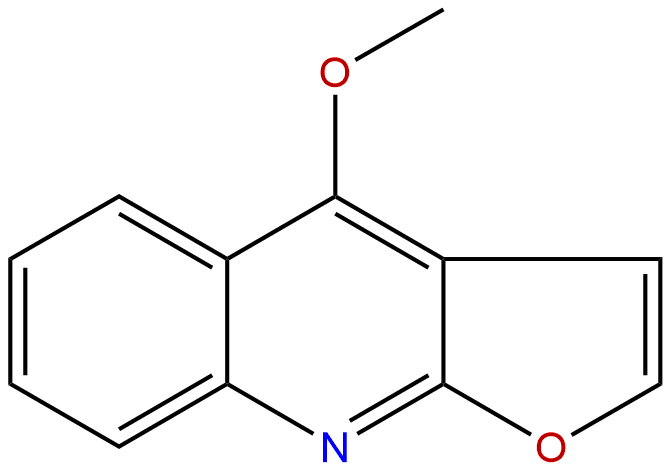
DictamnineCAS No.:484-29-7
|
||||||||||
 |
|
|
||||||||

| Catalogue No.: | BP0487 |
| Formula: | C12H9NO2 |
| Mol Weight: | 199.209 |
Product name: Dictamnine
Synonym name: 4-Methoxyfuro[2,3-b]quinoline
Catalogue No.: BP0487
Cas No.: 484-29-7
Formula: C12H9NO2
Mol Weight: 199.209
Botanical Source: Densefruit Pittany Root-bark
Physical Description:
Type of Compound: Alkaloids
Purity: 95%~99%
Analysis Method: HPLC-DAD or/and HPLC-ELSD
Identification Method: Mass, NMR
Packing: Brown vial or HDPE plastic bottle
Storage: Store in a well closed container, protected from air and light. Put into refrigerate or freeze for long term storage.
Whenever possible, you should prepare and use solutions on the same day. However, if you need to make up stock solutions in advance, we recommend that you store the solution as aliquots in tightly sealed vials at -20℃. Generally, these will be useable for up to two weeks.
The product could be supplied from milligrams to grams
Inquire for bulk scale.
Description:
Dictamnine shows anticholinesterase, anti-inflammatory, mutagenic, and has antimicrobial activity against bacteria and fungi. It has the ability to exert cytotoxicity in human cervix, colon, and oral carcinoma cells, it at higher concentrations(≥100uM) has potential hepatotoxicity because of the cell membrane damage and mitochondrial membrane damage.
References:
Rev. Bras. Farmacogn., 2012, 22(2):374-80.
Anticholinesterase activity evaluation of alkaloids and coumarin from stems of Conchocarpus fontanesianus
METHODS AND RESULTS:
Conchocarpus fontanesianus (A. St.-Hill.) Kallunki & Pirani, Rutaceae, popularly known as pitaguará, is a native and endemic tree from São Paulo and Rio de Janeiro States, Brazil. Based in the information that anticholinesterasic derivatives could act as new prototypes to treatment of Alzheimer disease, this work describes the fractionation guided by evaluation of the anticholinesterase activity of the ethanolic stems extract from C. fontanesianus.
CONCLUSIONS:
This procedure afforded the alkaloids Dictamnine (1), γ-fagarine (2), skimianine (3), and 2-phenyl-1-methyl-4-quinolone (4), as well as the coumarin marmesin (5).
Yeast. 2008 Sep;25(9):631-41.
Global gene expression profile of Saccharomyces cerevisiae induced by dictamnine.
Dictamnine, a natural plant product, has been reported to have antimicrobial activity against bacteria and fungi; however, the Dictamnine response mechanisms of microorganisms are still poorly understood.
METHODS AND RESULTS:
We have shown that Dictamnine has antimicrobial activities against the model fungus Saccharomyces cerevisiae, with a minimum inhibitory concentration (MIC) value of 64 microg/ml. Commercial oligonucleotide microarrays were used to determine the global transcriptional response of S. cerevisiae triggered by treatment with Dictamnine. We interpreted our microarray data using the hierarchical clustering tool, T-profiler. Several major transcriptional responses were induced by Dictamnine. The first was the induced environmental stress response, mainly under the control of the Msn2p and Msn4p transcription factors, and the repressed environmental stress response in genes containing the PAC (RNA polymerase A and C box) and rRPE (ribosomal RNA processing element) motifs. The second was the Upc2p-mediated response involved in lipid biosynthesis. The third comprised the PDR3- and RPN4-mediated responses involved in multidrug resistance (MDR). Finally, the TBP-mediated response was induced with Dictamnine treatment.
CONCLUSIONS:
TBP is an essential general transcription factor involved in directing the transcription of genes. Quantitative real-time RT-PCR was performed on selected genes to verify the microarray results. Furthermore, morphological transitions during Dictamnine exposure to S. cerevisiae L1190 (MATa/alpha) were examined, using confocal laser microscopy.
Chinese Agricultural Science Bulletin, 2009, 25(16): 21-4.
Study on in Vitro Antifungal Activity of Dictamnine against Candida albicans.
Candida albicans (C. albicans) and other fungi important human and veterinary pathogens.
METHODS AND RESULTS:
The minimal inhibitory concentration (MIC) of Dictamnine alone and in combination with fluconazole (FLC) against clinical 22 clinical Candida albicans were tested, and checkerboard assay was used to analyze the ractional inhibitory concentration index (FICI) of the combination of Dictamnine and FLC.
CONCLUSIONS:
The result showed that Dictamnine had good antifungal activity alone and in combination with FLC against Candida albicans.
Chinese Journal of Experimental Traditional Medical Formulae, 2012, 18(14):128-31.
Isolation and Anti-inflammatory Effect of Dictamnine Extracted from Dictamni Cortex.
To detect the anti-inflammatory effects of ethanol extracts and Dictamnine extracted and isolated from Dictamni Cortex.
METHODS AND RESULTS:
High performance centrifugal partition chromatography method was used for separation of the essential Dictamnine,and anti-inflammatory effects of ethanol extracts and Dictamnine were investigated by xylene-induced aruical swelling in mice and the abdominal capillary permeability in mice.Separation was performed with a two-phase solvent system composed of hexane ethylacetate-ethanol-water(1∶1∶1∶1).The purity of Dictamnine obtained was 98% determined by high performance liquid chromatograph.The results showed that each dosage of ethanol extracts could significantly(P0.05) suppress the mouse auricle which caused by the xylene swelling(being 44.26%,52.46%,44.26%,respectively),as compared with the control group.The medium-dosage group of Dictamnine could obviously(P0.01) suppress the mouse auricle but the dosage was not increased significantly in abdominal capillary permeability in mice compared with control group.
CONCLUSIONS:
HPCPC is a recommendable method to prepare and purify the dictamnie with good separation and the method is simple,accurate and easy to operate.The results showed that ethanol extracts and Dictamnine showed different anti-inflammatory effect in variety of animal models of anti-inflammatory.
HPLC of Dictamnine

HNMR of Dictamnine
